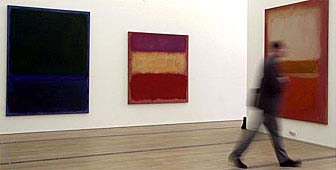Rothko exhibition faces challenge of popularity

An exhibition near Basel of paintings by Mark Rothko is destined to be a resounding success even by the high standards of the museum where it can be seen, the Beyeler Foundation in Riehen. Perhaps even too successful.
It includes the legendary “Rothko Room” from the Phillips collection in Washinton, and the equally well-known Harvard murals – all of them with paintings being loaned for the first time in their entirety.
And apart from other works on loan from private and public collections – many not shown for decades – there are two canvasses owned by the Teheran Museum of Contemporary Art which are being loaned for the first time in years.
Some 75 paintings by Rothko provide a sweeping look at the work of a modern master who was one of the most important of the Abstract Expressionists, famous mainly for his large-format paintings with their superimposed rectangles on a monochrome background.
Oliver Wick, curator of the exhibition, accepts that his biggest fear is that it risks being a victim of its own success before it ends on April 29.
Referring to the expected high influx of visitors, he told swissinfo: “Dialogue between the picture and the viewer was very important to Rothko. He saw a canvas as more than a painted surface, believing it only came to life with the viewer in front of it.
“The artist himself would contemplate his own paintings for hours, even for weeks. This exhibition requires of the visitor quiet moments, moments for sitting on a bench while contemplating the pictures.”
To facilitate this and in accordance with the artist’s wishes, a maximum of six people at a time will be allowed into the “Rothko Room”, which consists of four large paintings.
But however many visitors who are in the museum at any one time, one thing is certain. They are all in for a treat – an artistic feast for the eyes.
The exhibited paintings are drawn from all phases of the career of Rothko, who was born in Russia in 1903 and grew up in the United States after his family emigrated there when he was nine-years-old.
In the years leading up to his death – by suicide in 1970 – Rothko strongly stipulated how he wanted his work to be exhibited. Faithful to the artist’s ideals, the Beyeler Foundation has, in the words of Wick, created “densely-hung spaces with precisely specified installations.”
Or to put it another way, intimate spaces whose installations are aimed at almost overwhelming the viewer.
The exhibition is entitled “Mark Rothko – A Consummated Experience between Picture and Onlooker”.
This is from a quote by the artist which reads in full: “No possible set of notes can explain our paintings. Their explanation must come out of a consummated experience between picture and onlooker. The appreciation of art is a true marriage of minds. And in art, as in marriage, lack of consummation is grounds for divorce.”
by Richard Dawson

In compliance with the JTI standards
More: SWI swissinfo.ch certified by the Journalism Trust Initiative
You can find an overview of ongoing debates with our journalists here. Please join us!
If you want to start a conversation about a topic raised in this article or want to report factual errors, email us at english@swissinfo.ch.